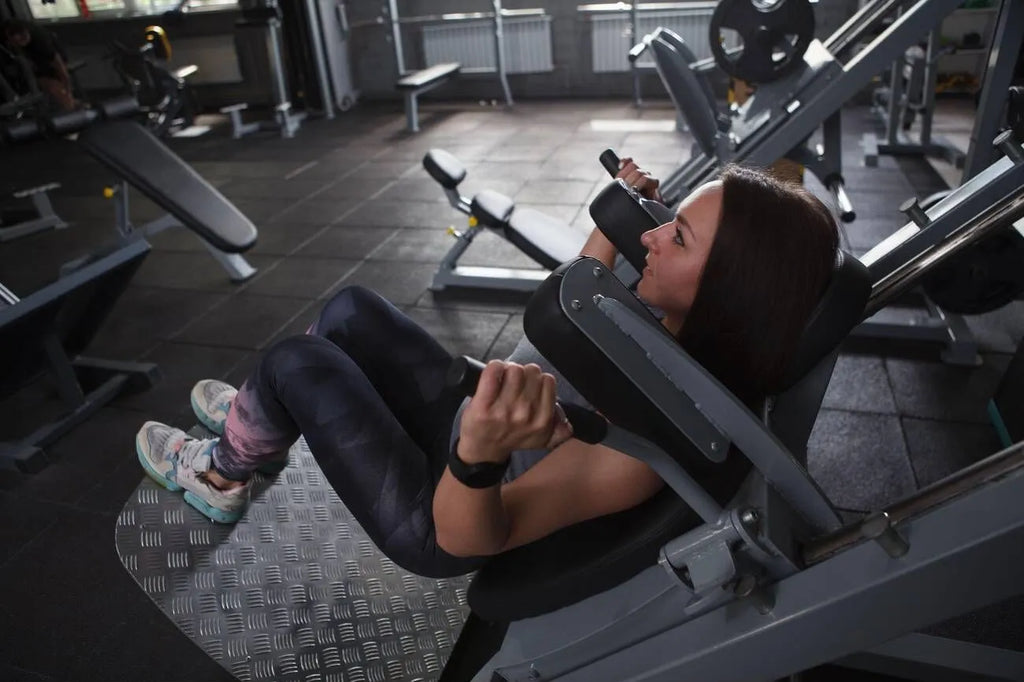7 Best Hack Squat Alternatives You Should Try


When it comes to lower body exercises, the hack squat is a popular choice among fitness enthusiasts. The hack squat targets numerous muscle groups and is effective in building strength and muscle mass.
However, due to the unavailability of hack squat machines in some gyms or personal preference, it is essential to find alternative exercises that can provide similar benefits. In this article, we will explore a variety of hack squat alternatives that allow you to strengthen your lower body without relying on the hack squat machine.
Hack Squat Exercise
Before delving into alternative exercises, it is crucial to understand the hack squat exercise itself. The hack squat involves positioning your body under a barbell with your feet shoulder-width apart. With your back against the exercise platform, you descend into a squatting position and then push back up to the starting position.
During a hack squat, various muscles are engaged, including the quadriceps, hamstrings, glutes, and calves. The exercise also strains the knee joint, making proper technique and precautions vital. Inadequate form or exceeding your limits can lead to injuries, so it is essential to be aware of safety considerations and common mistakes associated with the hack squat.
Hack Squat Alternatives
Barbell Squat
The barbell squat is a versatile alternative to the hack squat that effectively targets the lower body muscles. To perform a barbell squat, start with the barbell on your upper back, feet shoulder-width apart. Slowly lower into a squatting position, keeping your core engaged and knees tracking over your toes. This exercise primarily works the quadriceps, hamstrings, and glutes.
One of the major benefits of the barbell squat is its ability to engage multiple muscle groups simultaneously. Variations such as front squats, sumo squats, and Bulgarian split squats allow you to shift the focus to different areas of the lower body, providing variety and targeted muscle activation.
When squatting in a squat rack or power rack, it's important to prioritize safety. Use spotter arms to catch the barbell if you fail a rep, preventing injury. Additionally, ensure the J-cups are set at the correct height for your starting position. Proper use of these safety features allows you to squat with confidence and reduces the risk of accidents.
Leg Press
The leg press is another effective alternative to the hack squat that can be found in most gyms. In this exercise, you sit on a machine with a weighted platform, place your feet shoulder-width apart on the platform, and push it away from your body. This motion engages the quadriceps, hamstrings, and glutes in a similar way to the hack squat.
Compared to the hack squat, the leg press offers a different range of motion and may put less strain on the knee joint. However, it is crucial to maintain proper form and avoid excessively heavy weights to prevent injury. Additionally, various leg press machines, such as the horizontal leg press, vertical leg press, or 45-degree leg press, provide variations that target specific muscle groups.
Goblet Squat
The goblet squat is a popular alternative to the hack squat that requires only a single dumbbell or kettlebell. In this exercise, you hold the weight close to your chest, squat down, and then push back up to the starting position. By holding the weight in front of your body, you engage your core muscles and maintain an upright position, targeting the quadriceps, hamstrings, and glutes.
The goblet squat offers advantages such as improved posture, increased upper body activation, and enhanced core stability. This exercise can also be modified by using different weights or equipment variations like a sandbag or medicine ball, allowing you to continually challenge yourself and progress.
Belt Squat
The belt squat is a unique alternative to the hack squat that involves using a weighted belt or harness. Rather than placing the weight on your shoulders, this exercise suspends the weight between your legs. By attaching the weight to the belt, you can perform the squat motion without the need for a barbell.
The belt squat specifically targets the quadriceps, glutes, and hamstrings, providing an intense lower body workout. Additionally, the belt squat can be easily adjusted to accommodate your fitness level and weight preferences. However, it is important to have access to a belt squat machine or a suitable attachment to perform this exercise correctly.
Landmine Squat
The landmine squat is a versatile exercise that can be performed using a landmine attachment and a barbell. In this exercise, you place one end of the barbell into the landmine attachment or wedge it into a corner, holding the other end with both hands. From a squatting position, you drive upward, engaging the quadriceps, hamstrings, and glutes.
The landmine squat offers advantages such as reduced pressure on the lower back compared to traditional squats and hack squats. It also allows for greater emphasis on unilateral training, which can help correct muscle imbalances and improve stability. Variations of the landmine squat, such as sumo landmine squats or staggered stance landmine squats, further target specific muscle groups and provide variety.
Sissy Squat
The sissy squat is a challenging alternative that isolates the quadriceps and targets the rectus femoris muscle, located in the front of the thigh. To perform a sissy squat, stand with your feet shoulder-width apart, lean back, and lower yourself down while keeping your knees and ankles in alignment. This exercise requires careful balance and control, making it suitable for users at an intermediate or advanced fitness level.
The sissy squat offers benefits such as improved knee stability and greater range of motion compared to hack squats. However, due to the potential strain on the knee joint, it is crucial to practice proper technique and avoid excessive weights. Additionally, incorporating assistance from a stability ball or hand support can aid in maintaining balance throughout the exercise.
Split Squat
The split squat, also referred to as the stationary lunge, is an alternative exercise that focuses on unilateral training. To perform a split squat, stand with one foot forward and the other foot positioned behind you. Lower your body by bending both knees until your back knee is nearly touching the ground, then drive through the front foot to return to the starting position.
Split squats primarily target the quadriceps, glutes, and hamstrings while also engaging the core for stability. By isolating each leg, split squats can address muscle imbalances and enhance coordination. Variations such as Bulgarian split squats or walking lunges further challenge the lower body and provide variety in your workout routine.
Comparison and Selection
When selecting the best hack squat alternative for your fitness routine, it is important to consider various factors. Firstly, identify the targeted muscle groups you wish to focus on and choose an exercise that effectively engages them. Secondly, prioritize safety and injury prevention by selecting exercises that align with your skill level and fitness goals. Finally, evaluate the equipment availability and convenience of each alternative exercise, ensuring that you have access to the necessary tools for proper execution.
To further assess the effectiveness of each alternative exercise, consider factors such as overall muscle activation, potential for progression, and carryover to other exercises and activities. It is recommended to consult with a fitness professional or trainer who can guide you in selecting the most suitable alternatives based on your personal preferences, goals, and specific needs.
Form and Technique in Hack Squat Alternatives
Proper form ensures that you're engaging the targeted muscles effectively, optimizing the exercise's benefits while minimizing injury risks. It's crucial to maintain a neutral spine throughout, avoiding excessive arching or rounding of the back. This posture provides a stable base, crucial for back health. Additionally, always ensure your knees track over your toes, especially during squats and leg presses. Misalignment can stress the knee joint and ligaments, leading to potential issues. Incorporating knee sleeves for squats can be particularly beneficial here, as they provide added support and stability, ensuring that the knees remain protected and aligned correctly. Engaging the core is another vital aspect; think of it as the central powerhouse supporting and driving your movements. Proper breathing, exhaling during exertion and inhaling during relaxation, can significantly enhance your performance.
Foot positioning plays a pivotal role in these exercises. The placement can influence muscle activation; for instance, a wider stance might target the inner thighs more, while a narrower one emphasizes the quadriceps. As you explore hack squat alternatives, remember the value of tools like knee sleeves. They not only boost confidence by providing a safety net but also assist in achieving a deeper range of motion, essential for muscle development. Even if you're experienced, it's beneficial to periodically check your form. Recording your sessions or seeking feedback from a fitness professional can provide insights, ensuring you're not just lifting heavy but lifting right.
Conclusion
Incorporating alternative exercises for lower body strength and muscle development is an important aspect of any well-rounded fitness routine. While the hack squat is a popular choice, the availability of alternative exercises allows individuals to achieve similar outcomes without relying on hack squat machines. Options such as the barbell squat, leg press, goblet squat, belt squat, landmine squat, and split squat offer a diverse range of movements that target various muscle groups in the lower body.
By understanding the description, technique, benefits, and limitations of each alternative exercise, you can make an informed decision regarding the best hack squat alternative for your individual needs. It is important to continually challenge yourself, experiment with different variations, and listen to your body to find what works best for you. Remember to prioritize safety, proper form, and gradual progression to efficiently strengthen your lower body and achieve your fitness goals.










